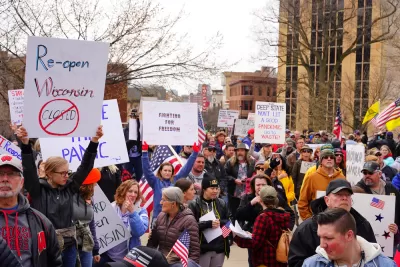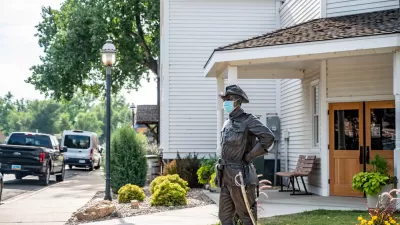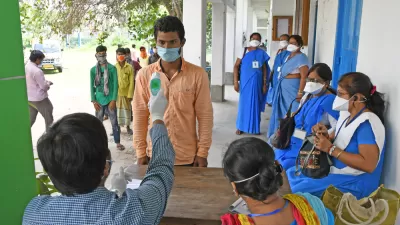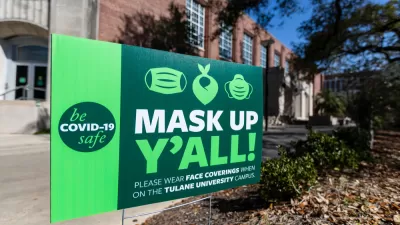An analysis by the Associated Press found that voters in counties that are disproportionately impacted by the coronavirus were far more likely to support President Trump's reelection than voters in less-impacted counties.

"Out of 376 counties with the highest number of new coronavirus infections per capita, a whopping 93% went for Trump, according to an analysis by the Associated Press," writes science correspondent, Amina Khan, for the Los Angeles Times newsletter, Coronavirus Today, on Nov. 6.
Most of these were rural counties in Montana, the Dakotas, Nebraska, Kansas, Iowa and Wisconsin. These also happen to be the kinds of areas where people put less stock in protective public health measures such as social distancing and mask-wearing.
During the spring peak in New York City, New Jersey, New Orleans, and Detroit, the prevailing wisdom was to link the outbreak with population density—whether it be the packed subways or crowded sidewalks as opposed to the "natural social distancing" associated with rural areas. The AP analysis is important because the focus on preventing COVID infections shifts to behavior—such as the willingness to wear masks, practice social distancing, and avoid indoor mass gatherings, e.g., political rallies or church services, rather than population or residential density.
The differing views on President Trump's performance were also indicative of the urban-rural divide in addition to the debates over public health vs. the economy and public health vs. individual rights/civil liberties. In any case, state health officials will need to carefully target their messages to deal with the new geography of the pandemic.
"Public health officials need to step back, listen to and understand the people who aren’t taking the same stance" on mask-wearing and other control measures, said Dr. Marcus Plescia of the Association of State and Territorial Health Officials [ASTHO] in the AP article on the analysis showing the high correlation of case incidence with support for President Trump.
The association has launched a #MaskUp Campaign. Looking at the track record of a similar campaign in North Dakota, it doesn't seem to have been very effective. From a related post, "Can the Public Be Educated to Wear Masks?" October 5, 2020:
The Harvard Global Health Institute/Brown University School of Public Health COVID Risk Levels Dashboard shows that the case incidence has since more than doubled in North Dakota, with 52.7 daily new cases per 100k people (7-day moving average) based on Oct. 2 data, over four times the national average of 13 cases per 100k people.
North Dakota: highest COVID-19 case incidence in the nation and world
The North Dakota COVID-19 case incidence has more than tripled since then. It was 176 per 100k (7-day rolling average) on Nov. 8, according to The Washington Post. Next highest: South Dakota, with 134 daily new cases/100k. The U.S. average was 32 cases/100k.
On an international level, The Post indicates that the Czech Republic and Belgium had the highest case incidence, each with 102 cases/100k.
There appeared to be little evidence that the pandemic had any effect on the election results in North Dakota in the sense that the GOP swept all races.
"President Trump posted another lopsided victory Tuesday in North Dakota, getting 65% of the vote, compared to 63% four years ago," reported The Bismarck Tribune. "Republican Gov. Doug Burgum captured 66% of the vote in his bid for reelection."
A separate Bloomberg analysis correlating high COVID-fatality counties with Trump support confirms the AP analysis of case incidence.
"In those counties that ranked among the top 10% for Covid-19 deaths per person, Trump’s margin of victory improved an average of 2.8 percentage points, increasing from 23.6 points in 2016 to 26.4 points this year," wrote Andre Tartar, David Ingold, Jeremy C.F. Lin and Paul Murray on Nov. 4.
Related in Planetizen:
- England Begins Second Lockdown to Protect the National Health Service [see sub-heading: "The U.S. sets coronavirus record, but voters more focused on the economy"], Nov. 8, 2020
FULL STORY: Coronavirus Today: A new pandemic battle

Alabama: Trump Terminates Settlements for Black Communities Harmed By Raw Sewage
Trump deemed the landmark civil rights agreement “illegal DEI and environmental justice policy.”

Planetizen Federal Action Tracker
A weekly monitor of how Trump’s orders and actions are impacting planners and planning in America.

Why Should We Subsidize Public Transportation?
Many public transit agencies face financial stress due to rising costs, declining fare revenue, and declining subsidies. Transit advocates must provide a strong business case for increasing public transit funding.

Understanding Road Diets
An explainer from Momentum highlights the advantages of reducing vehicle lanes in favor of more bike, transit, and pedestrian infrastructure.

New California Law Regulates Warehouse Pollution
A new law tightens building and emissions regulations for large distribution warehouses to mitigate air pollution and traffic in surrounding communities.

Phoenix Announces Opening Date for Light Rail Extension
The South Central extension will connect South Phoenix to downtown and other major hubs starting on June 7.
Urban Design for Planners 1: Software Tools
This six-course series explores essential urban design concepts using open source software and equips planners with the tools they need to participate fully in the urban design process.
Planning for Universal Design
Learn the tools for implementing Universal Design in planning regulations.
Caltrans
Smith Gee Studio
Institute for Housing and Urban Development Studies (IHS)
City of Grandview
Harvard GSD Executive Education
Toledo-Lucas County Plan Commissions
Salt Lake City
NYU Wagner Graduate School of Public Service





























